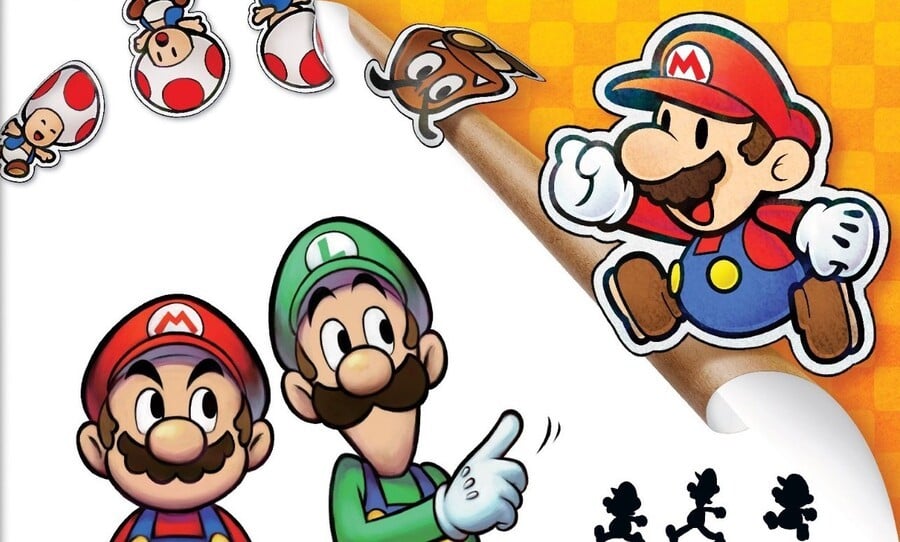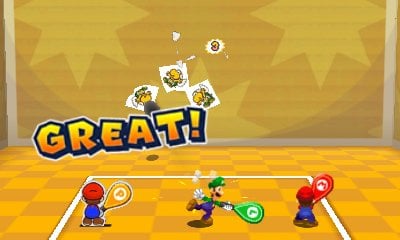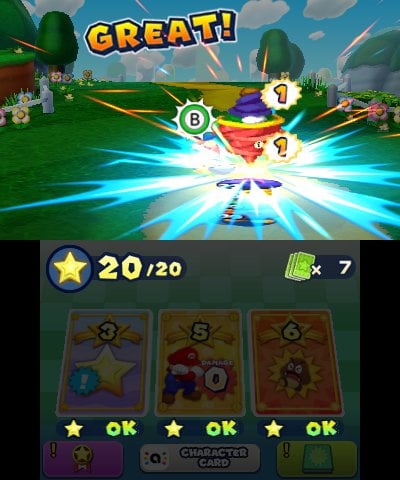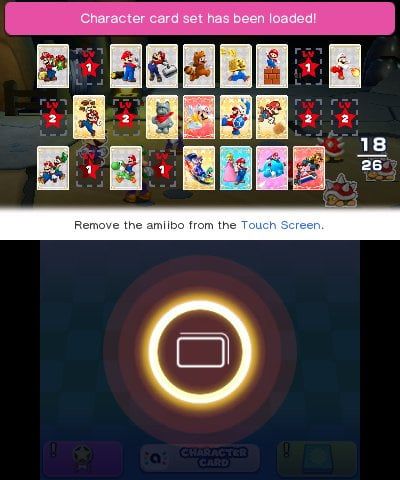
Transforming a platformer into an RPG never did seem like an easy recipe for success, but somehow the Mario series has caught this rare form of lightning in a bottle not only once, not only twice, but three times over. The classic SNES title Super Mario RPG: Legend of the Seven Stars established a winning formula of comedy, adventure and unique gameplay which has continued on to this day, and now two different series carry the torch for Mario's RPG outings; both known for their strong writing, fun mechanics and colourful settings. When these worlds collide it's about as manic as you might expect.
Announced at this year's E3, Mario & Luigi: Paper Jam - called Mario & Luigi: Paper Jam Bros. in Europe - is the second title from AlphaDream on 3DS, but there's more than a little extra star power this time around. In the surprise crossover of the year the adorable Paper Mario crew are along for the ride as well, bringing half their kingdom with them. How does it all happen? Well, we open as ever in Peach's castle, where a curious Toad is wandering around a draughty storage room with Luigi. It instantly sets up a charming atmosphere with a fun rendition of the Luigi's Mansion theme and a silly mission to catch a stray mouse. Of course it isn't long until our clumsy hero stumbles across a magic book, which promptly unleashes (or...unfolds?) the entire paper-thin population of a parallel Mushroom Kingdom into the sky.
Paper Goombas and Toads alike are left to fall all across the land, excited and terrified in equal measure. When a paper Princess Peach arrives things really get interesting - as famous characters are introduced to their inter-dimensional counterparts for the first time. Even Bowser gets his own paper rival, and once they're done arguing both of them inevitably team up to kidnap their own personal Princess. It's about as much story as is needed to get the concept moving, basically explaining the Paper Mario series as taking place within a parallel world. Works for us!

After spending a good chunk of time with the game, we'll start by saying this is definitely a Mario & Luigi title at its core. There are absolutely some new mechanics and visual effects that make great use of the paper characters and environments, but it's rooted firmly in a three-dimensional Mushroom Kingdom. Anyone who's played Dream Team in particular will feel right at home, though some pretty interesting changes have been implemented to keep some of the best features of both series'.
Paper Mario himself is rendered beautifully in all his mute quirkiness, and it makes for some funny scenes where the Bros' babbling discussions are met with blank stares from their new companion. Adding a third character into the mix feels like one of the biggest changes made to date, and it has an equal effect on combat and movement. Exploring as a party of three means timing your jumps differently, as Paper Mario is now linked to the 'Y' button for all actions. It takes a bit of getting used to, especially when dodging attacks in the middle of a battle, but it feels totally natural after a little practice.
Combat has been re-invigorated by our new pal as well, with the Bros now arranged in a triangular formation during battle. Paper Mario sticks to the back, boasting some unique abilities that mesh perfectly with the typical "jump-hammer-dodge" system we're used to. By making up to six copies of himself he ends up packing more of a punch than ever, able to split up and hammer multiple enemies at once to create valuable openings for further attacks. On top of that he can also initiate some of the game's most powerful moves - Trio Attacks. These are like super-charged Bros attacks that involve all three characters and a whole lot of paper. Copies also soak up damage, though it takes a full turn to create more. Rather than feeling overpowered, it's been designed to compliment Mario and Luigi's traditional attack by creating opportunities and covering for them when necessary. A powerful ally indeed.

The environments themselves have been fairly traditional so far, moving from green fields into a desert setting complete with dreary underground grotto. Enemies - whether paper or otherwise - still roam around looking for trouble, but our favourite moments are when seemingly open landscapes are quickly made more complex by the arrival of new cardboard structures. Courtesy of Kamek, these sudden changes help blur the line between dimensions, and we hope to see many more examples of them quite literally popping up as we progress.
The Toad hunt which we saw demoed at E3 is actually part of a much broader quest system that's totally new to the series. Certain sections of the game play out as isolated challenges, and completing them adds to the total amount of paper Toads you've saved. For example, you might need to rescue several of them within the time limit, break blocks in a Jenga-esque balancing act to free them, or herd a panicked group to safety. You'll either come across these yourself or visit a Lakitu center to choose from a list of available missions. There's been plenty of variety so far, especially since you can replay quests at a harder difficulty, though we especially love being able to sprint with 'x' and tackle the poor guys to the ground. It's just too satisfying for us to feel guilty.

As we previously reported, the game also supports a bunch of different amiibo from the Mario series. They're used to create character cards, another new system that's designed to help out in battle. It left us scratching our heads slightly as we tried to work out the specifics as to how it all worked, but essentially it's rather like building your own deck of special abilities, with each amiibo generating a different variety. You either purchase or earn a blank card in-game, and then use an amiibo to bring it to life. We were able to test with Bowser and Yoshi; the former creating attack cards while the latter granted a stat boost or cured our team of status conditions. You can use these cards once per battle, though we'd be more excited if it weren't so cumbersome and fiddly. Even after registering the amiibo and generating your ability cards, you need to have it with you ready to scan again whenever you want to use one of them. For a portable title this could potentially make it a bit too much hassle, especially if you're playing on the move.
There are a host of other tweaks that help this entry feel distinct. Enemies now display a level value beneath their names, showing how strong they are compared to your team. An "emergency block" acts as a last minute form of defense, giving you the option to brace yourself in order to take less damage from attacks if you can't dodge them entirely. Choosing a bonus stat to improve for each level up isn't possible anymore, but more powerful rank up bonuses remain that can only be applied once per five levels or so.
This isn't even to mention the boss fights where you'll hop onto a giant papercraft Mario and battle hordes of enemies in an arcade-style brawl! Like Dream Team's giant Luigi sections, these break up the usual gameplay with a completely new control scheme built around charging enemies while avoiding their attacks. They're excellent, tank-like confrontations with real weight to them - ironically enough.
All of this amounts to something ambitious yet familiar; this is a Mario & Luigi game through and through with some surprising new features that have us excited to play more. You're frequently reminded that the Bros. are dealing with two armies this time around, and the journey ahead is made out to seem more arduous than ever as a result. Bowser's Castle constantly looms in the distance, as the game pans forward to keep it at the back of your mind. The setup might be a simple one so far, but we bet there's plenty hidden with the pages of Paper Jam.

Comments 42
"Choosing a bonus stat to improve for each level up isn't possible anymore...."
Seriously? That's a little disappointing.
I wonder where Paper Luigi is and what happened to him.
Looking forward to this. Will be great to play over xmas as I travel to see the family.
I never had any doubt that this game would be great. So the naysayers can kiss my behind.
A week before my birthday too, thank you Nintendo.
I will pick it up eventually. December is reserved for Xenoblade X for me.
After Sticker Star being rather mediocre and apparently Dream Team wasn't good (still haven't played it), I have high hopes, but low expectations for this.
I'll be checking this game out looks better n better each time but would prefer it on the Wii U playing it on the big screen.
@IKAY Me too.
I have my doubts, I'll have to wait until the game is out.
i have no doubts that I am going to love this game. I don't care what other people say. This game is full of charm and I can't wait to play it. January can't come fast enough for me.
Why does Europe add "Bros" to the end of the titles for these games? Do they need to be established as brothers in the fear of how rampantly incestuous some parts of Europe are?
While I do wish that there was some more non-Sticker Star references in this game, I know that it most certainly will be better! (Seriously, there's at least a story this time!).
I literally can't stop thinking of Mega Man now whenever I see this game because of the whole "Battle Card" thing.
@3DiddyKong Weren't battle cards in Baten Kaitos, too?
I knew Mario & Luigi wouldn't disappoint. Shame you can't choose a bonus stat anymore, though I guess the new additions will help balance it out.
This does look pretty sweet
@DBPirate @brewsky Seriously, though... The idea of improving one bonus stat is a novel idea, but I think it's outdated, especially when you consider the fact that the bonus stat thing is pure luck. I mean, what's the point of choosing one more stat to upgrade by most likely one point? I say let the game choose the points for you, like Pokemon.
Ah, fine. I'll get this game. I happen to personally enjoy Dream Team and Sticker Star (with the former by a margin).
The lack of bonus stat choices doesn't bother me as I felt that this feature has went from awesome to meh for me. What does bother me is that Alpha Dream keeps rehashing the same dang box art since Bowser's Inside Story. I mean, look at Superstar Saga and Partners in Time's box arts. Why can't they make box arts like those anymore?
@VanillaLake Never heard of Baten Kaitos, so I wouldn't know, I just said Mega Man because i'm used to that term from Mega Man Star Force and the character cards kind of remind me of the Mega and Giga class cards where a boss character would be summoned to unleash a powerful attack on the enemy.
@brewsky Well when you think about it, the fact that Paper Mario's attacks compensate for that just only makes the game easier than Dream Team.
Getting this even if its a seven or a six. Would really love it if there's a preview for FE Fates as well.
The writing in these Mario RPG games are really good. It's the humour that keeps me playing them, and the turn based game play required skills unlike other Japanese RPG.
Wow, Nintendo, you never cease to amaze me in your mission to make inane, insipid games based on what are otherwise worthwhile franchises. Sickening.
@brewsky I had spent a week deciding how to "EV train" my characters lol now it's all useless. Oh well. I bet it was because people were struggling because they had put stats in the wrong things or something.
@Nintendolife Have you guys seen the papercraft set on the Nintendo store? Thought they were amiibo to start with, but they look like just figures
http://store.nintendo.co.uk/games-3ds/mario-luigi-paper-jam-bros.-mario-classic-colours-amiibo-pack/11185227.html
I kind of feel insulted that Battle Cards are being advertised as a new feature, supposedly adding to "previously boring mechanics of mostly jumping and hammer attacks", when all they are is items which the Mario & Luigi games have had all along, albeit now with the option of "Pay to Win".
Partners in Time was the absolute worst Mario & Luigi game in my opinion, although that was in part due to all special attacks being items and only items, which Sticker Star had an even worse version of. Still, I hope Paper Jam has more up its sleeve than Mario fighting along side another version of Mario and Bowser fighting along side another version of Bowser.
@3DiddyKong Okay.
@DarkKirby I agree, I didn't like Partners in Time. I liked Superstar Saga and Bowser's Inside the Story. About Paper Mario, Sticker Star is the worst, the best is The Thousand-year Door, in my opinion. Do you have to pay for the cards in this new game?
@DarkKirby I never got the hate for Partners in Time. If anything it improved almost everything wrong with Superstar Saga and knowing people like it better makes me really scratch my head.
@DarkKirby @WaveGhoul OK, I get it, you have to buy Amiibo for in-game power-ups... :S I like both sagas but I don't like how they are turning recently, Nintendo to blame most probably. Mario Party, Animal Crossing, Paper Mario, and Mario& Luigi now.
@Koopa-King the whole game is not that enjoyable compared to the other two, even though, obviously, is technically superior than the GBA entry.
Does this mean I've got to buy the necessary amiibo or nfc cards just to get through this?
I'm really disappointed that I have to wait until January to get this, and I'm almost wondering if it'll be worth it, because it seems like Alphadream id doing to this game what Intelligent Systems did to Paper Mario where they changed so much from the original formula. I just hope that the entire plot line isn't based on rescuing toads.
It seems like Starlow is the only original character from the Mario RPGs to make it into this game, aside from a small cameo of Antasma.
... Where are the Paper Mario OCs like Dimentio? And they replaced Popple with Nabbit. I don't like that one bit.
As was a few months ago when it was announced, I am so effing excited for this. I am enjoying the crap out of Dream Team and loved Sticker Star so this is equivalent to when Sonic Youth toured with Pavement to me. Can't get here sooner.... Now I decide Digital or Physical... Hmmmm
I'm super excited for this one, probably far more than I ever was for Dream Team. Sadly Dream Team was a bit of a letdown (and let's face it, Bowser's Inside Story is a tough act to follow). I'm hoping Paper Jam does the series justice again, and revives the since-fallen Paper Mario series.
It would be so nice to see a PROPER sequel and return to form for that series. At the very least I'll take a port of The Thousand Year Door on 3DS. Make it happen, Ninty. Make it happen.
@TerrapinJess You LOVED sticker star? I never thought Id see the day.
The stuff about Battle Cards and whatnot in the Direct made me lose faith in this game. I won't write it off entirely, but I certainly won't buy it before talking to other players about it. Sticker Star was awful, and I don't want to waste money like that again.
@Koopa-King I did! It didn't blow me away but I did like the collect-a-thon element of trying to collect all the stickers. There was just something about collecting everything and the art style and trying to fill that museum underground... Reminded me of collecting Pokemon cards back in the day
@Nashew Dream Team was very good. The pushy tutorials in the first half were annoying, but not enough to spoil it for me. Couldn't put the game down.
Can't wait for Paper Jam!
@VanillaLake Baten Kaitos had a battle system based entirely on cards. Different from how they work here as special items. I went crazy with that game. When I mastered my deck, I steamrolled everything! Loved it.
@stephenmunn Well, regardless of what I've heard, I am still planning on playing it, so I'll see if I agree with you. =P
I'm holding off on this until I hear if it has an actual Mario RPG-caliber story with actual characters and settings — all I'm seeing is Goombas and Toads in a plain grassy field. At this point in Dream Team's prerelease era, we'd already seen a variety of unique settings and original enemies and a new villain and references to previous Mario RPGs with Beanish and Hoohooligan characters. If Nintendo's killed off both Mario RPG serieses, I'm gonna be really pissed.
The potential of two Bowsers with dialogue is definitely promising, but after Sticker Star, I'm not letting myself get my hopes up for a Mario RPG again.
@Li_Bae So you did play it? Yeah, didn't thought so.
@stephenmunn Good to know, I never played Baten Kaitos. I know, however, there was a second game that did not come to Europe. The cards in Mario & Luigi Paper Jam look more like a buy-amiibo-to-win thing, which I don't really like.
Show Comments
Leave A Comment
Hold on there, you need to login to post a comment...